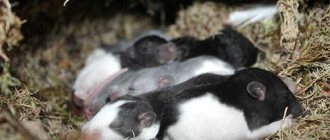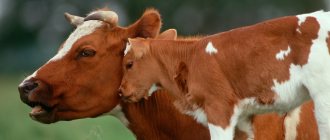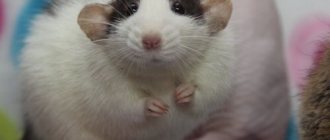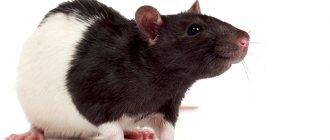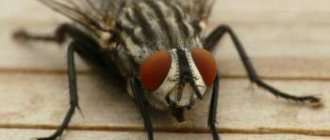Determining whether a female is pregnant can be challenging, especially if potential breeding has not been planned. This can be a very worrying time as a rat owner.
Pregnancy is a normal part of the life cycle. For the most part, the female's pregnancy proceeds smoothly, as nature intended. Sometimes this is not the case. This article will cover questions regarding normal aspects of pregnancy, problems that may arise during pregnancy, and factors that may affect pregnancy.
Pregnancy detection
To detect pregnancy in a female, it is not recommended to palpate the rat’s belly. Often the babies are too small to be felt in the womb, and even the gentlest manipulation can damage them. Palpation is safer after fetuses reach 14 days of age, but should still be done with extreme caution.
Traditional signs of pregnancy include:
- Termination of the estrus cycle.
- Copulation plug after mating.
- Changes in behavior.
- Weight gain.
- Hair loss around the nipples.
- Construction of a nest.
- Enlarged lower abdomen.
Let's look at each of the symptoms in more detail.
Conditions of detention
So, after mating, the female is separated from the male, then she only needs rest. Be sure to remove all entertainment accessories, hammocks, and tunnels from the cage. If the cage is two-level, access to the second level is closed.
Place as much filler as possible on the floor; it must be of good quality. When using wood chips, remember that they should not collect dust; if this is not the case, replace them with another filler. All this is done for safety reasons for the rodent and her babies.
The cage should contain only what is necessary:
- Feeders, you will need two of them.
- Drinking bowl.
- We need a house, if there was one, it will need to be replaced with a more spacious one.
The cage must be placed in a place that will be protected from bright light and drafts. If there are cats or dogs in the apartment, limit their access to the pregnant animal.
Closer to birth, the animal will begin to arrange a nest - she will need pieces of fabric and napkins, so make sure that they are available in the cage in advance. Do not forget that rats also require the attention of their owners, which is why it is recommended to handle them and stroke them, but with the utmost care.
Changes in behavior
Pregnancy changes the hormonal balance in female rats, which can sometimes cause changes in behavior. Your once docile rat may become more aggressive and territorial towards both people and other rats. An eccentric or aggressive female may become calmer.
Once pregnant, the female rat also shows no interest in males. A pregnant female will not react in any way to the smell of a male. A fertilized rat may also be more interested in food and steal from other females, and may be more protective of its food and hide it.
Signs of heat
Before breeding, you should find out what signs pets show that they are ready to mate.
Females
As a rule, estrus in females occurs every five to six days and lasts about 12 hours. If there is not one female living in your cage, but two or more, then you may sometimes notice how one can climb on top of the other and imitate sexual intercourse. In this way, the female shows that she is ready to reproduce. If you look at the vaginal opening during estrus, it will be wet, with a reddish-purple tint.
After the estrus ends, sexual hunting begins. It is at this time that rats begin to be ready for sexual intercourse. They begin to lick and sniff each other, often imitating intercourse during a break between games and food.
Males
As a rule, males do not have any sexual heat until the moment he sees the female. If he has reached sexual maturity, he will immediately climb towards the female to have sexual intercourse.
Weight gain tracking
Weighing your female rat before mating can give you a good basis for determining weight gain during pregnancy. It is also the most reliable method of determining and monitoring pregnancy from the very beginning.
- Scales
The best options for this are a small digital kitchen model with a flat surface or removable bowl large enough to accommodate an adult rat. Use a scale that will weigh in grams as accurately as possible.
- Signs of weight gain
The female may begin to gain weight within 24 hours of mating. In fact, there may be very few days during the entire pregnancy when a rat does not gain weight.
Daily weight gain ensures that babies are growing throughout pregnancy. The amount of weight a female will gain will depend on her early pregnancy weight, her diet, and the number of children she is carrying.
Once you start weighing your pregnant females, you can see a very clear picture of immediate, significant weight gain. This indicator is important to monitor during the period of slow steady gain with very significant weight gain in the last few days.
A typical full-term fetus averages 5-6 grams. A large litter can mean a lot of extra weight for your female. Healthy females with a decent litter can gain up to 90 grams. Sometimes a rat carries such a small litter that it makes it virtually impossible for the owner to determine pregnancy before giving birth.
- Weight fluctuations during pregnancy
Although weight gain is used to monitor a healthy pregnancy, it can also be used as a tool to help identify problems. Weight may vary during pregnancy. You may experience slight weight loss, a few days without weight gain, or sudden weight gain. These abnormalities are not necessarily abnormal or indicative of a problem.
Time passed without weight gain or continued weight loss usually indicates problems.
Persistent weight loss is usually a sign of reabsorption. Often weight loss is 12 grams per day or more. For the most part, fruits are reabsorbed without problems.
Sometimes incomplete reabsorption can lead to uterine infection. After losing a litter, monitor your female for any signs of infection or illness, such as abnormal vaginal discharge, high (or low) temperature, lethargy, persistent or obvious bleeding, loss of appetite, etc. A sick female should be seen immediately examined by your veterinarian.
Caring for a pregnant rat
During pregnancy, females are especially vulnerable. Not only their physiological state changes, but also their psychological state. Therefore, for the normal course of pregnancy, it will be necessary to provide the expectant mother with proper care.
Content
To ensure the rat's comfort, the following measures will need to be taken immediately after pregnancy is detected:
- Move the pet into a small cage, inside which there should be no play complexes, labyrinths, or running wheels. All interior items (house, drinking bowls, feeders) must be firmly secured.
- It is better to replace the usual filler with paper napkins or toilet paper.
- Move the cage to a remote room where the animal can hide from prying eyes and feel safe. At the same time, you need to take care of the microclimate in the room - it should be warm and dry inside, and you should also protect the fluffy from direct sunlight.
- The cage will need to be cleaned twice a week. During hygiene measures, the pet will have to walk around the room. It is not recommended to use detergents to wash the cage itself and everything in it. Safe baking soda will do the job perfectly.
After determining the rat’s permanent place of residence during pregnancy, under no circumstances should the cage be moved to another room or even to another place. Constant moving will cause discomfort to the animal.
Feeding
The diet of a pregnant rat is noticeably different from the menu of other pets. After all, the expectant mother needs a lot of energy and building material to carry rat pups normally. Therefore, nutrition for a pregnant female must be organized taking into account the following features:
- The basis of the diet, as before, should be grain. It is necessary to choose grain crops for feeding taking into account the preferences of the pet.
- As a source of protein, you need to give the rat more animal products - offal, lean meat, chicken cartilage, fish, shrimp, fermented milk products - low-fat cottage cheese, kefir.
- During the period of bearing babies, the rat needs more vitamins. Therefore, her menu needs to include a sufficient amount of fresh vegetables (zucchini, pumpkin, broccoli) and fruits (apple, banana, pear).
- During pregnancy, rodents often experience gastrointestinal disorders. To avoid digestive problems, you need to give your fluffy more fiber. Its natural sources are fresh grass (dandelion, plantain, fodder lettuce, parsley, dill).
Also, for a good metabolism, a pregnant female needs a large amount of fluid. Therefore, fresh water should always be available in drinking bowls.
The following foods are strictly contraindicated for pregnant rats: bell peppers, egg yolks, sour tomatoes, white cabbage, radishes, grapes, fresh milk.
Nesting
As pregnancy nears the end, certain hormones that increase maternal behavior in rats increase as well as decrease. When these changes occur, the female begins to build a nest. You can be sure that the babies will arrive within a few days. Some females build very simple nests, while others build complex ones that completely conceal the young.
In late pregnancy, it is a good idea to provide the female with nesting material. Try to avoid fabrics with holes or ties, as these can suffocate or injure your baby. You may also consider removing the hammocks or moving the female to a single-level cage to avoid injuring the babies who might fall. (Occasionally, females will build nests and give birth on ledges, in hammocks, or in hanging pipes.)
Hygiene
While your rat is pregnant, be sure to keep the cage clean. Cleaning should be carried out at least every 5 days. The last cleaning should be done 5 days before the start of labor, by thoroughly washing all the equipment and scalding it with boiling water.
The house and tray should be disinfected and the filler replaced. The bedding must always be kept clean and dry so that the animal does not inhale harmful fumes of ammonia and hydrogen sulfide. Please note that you can only wash the cage using baking soda; household chemicals are prohibited.
Stages of pregnancy
Once a female rat is fertilized, her entire system begins to change as her body prepares for the growth and development of her offspring. At 21-24 days after conception, 3 stages of pregnancy are distinguished. Let's look at the obvious changes you'll see in a rat at different stages.
- First stage of pregnancy
Appearance of a rat.
There are no immediate visual changes after conception. The fetuses are too undeveloped to cause any noticeable weight gain in the mother (although if you weigh the female, you will see the weight gain).
Appetite.
You may begin to notice a slightly increased appetite as her body requires more nutrition and energy to send to her children.
Behavior.
Most females do not show noticeable changes in behavior early in pregnancy. However, in others you may notice detachment or lack of energy.
The female will no longer go into estrus after fertilization. She will not be interested in the smell of a male rat.
- Second stage of pregnancy
Appearance.
In the second week of pregnancy, the female will begin to gain weight. She will look like a well-fed rat. Her hips may begin to widen a little. Towards the end of the second week, you may feel a slight swelling in your abdomen, although pressing on this area is not recommended as it may harm the fetus.
Appetite.
Appetite will increase and it is important to give your mother rat healthy treats as well as staple foods such as kibble.
Behavior.
No heats and no interest in the scent of male rats. May sleep more, may bite sometimes.
- Third stage of pregnancy
Appearance.
In the last week of pregnancy, the rat will change dramatically in appearance. Her weight will increase by leaps and bounds. And her belly will become pronounced and rounded. Some breeders describe a prenatal rat as if it had "swallowed a tennis ball" or "swallowed an orange." The hips will noticeably expand. If a rat is carrying a large litter, the skin may stretch to the point that the fur on its back appears thinner. This is most often seen in Rex rats.
Babies can now be felt by gently touching the belly, although it may hurt them if you press too hard. At the end of pregnancy, you may see movement in the abdomen as the baby reaches full term.
The nipples will become more pronounced and the hair around them will become thinner, making them easier for newborns to access.
Appetite.
Females with large litters may experience a sharp increase in appetite as their bodies require more food to feed their babies. Healthy treats and free feedings with healthy staples are encouraged throughout pregnancy.
Behavior.
As your rat approaches birth, he may show signs of aggression. This will depend on each rat. Some females never show aggression during pregnancy. Others will bite and want to be left alone.
The female may sleep more in the last week of pregnancy. She also usually builds a nest in anticipation of the upcoming birth.
Possible problems
The owner of a rodent must be attentive to the condition of the rodent. Most cases are normal, but complications rarely occur. And the problems that arise can lead to stress.
Urgent veterinary care should be provided in the following situations:
- Lethargy and lack of appetite in the rat;
- Discharge of pus and blood from the genital loop;
- Lack of movement of the pups in the abdomen can be detected in the last stages of pregnancy;
- The duration of labor takes more than 5 hours.
Vitamins and minerals during pregnancy
Deficiencies of vital nutrients can affect fertility and the health of offspring. It is important to provide your breeding and nursing rats with a well-balanced diet that meets their nutritional needs.
Vitamin A.
It has been proven that a lack of vitamin A throughout a rat's pregnancy leads to changes in the placenta and, as a result, to embryonic defects in addition to infertility.
Vitamin A is also critical during embryological growth, when cells multiply, and can lead to defects in the hindbrain, heart and skeleton. Deficiency later in life in rats can lead to abnormalities in the eyes, kidneys, heart, lungs and genitourinary system.
Severe deficiency of this vitamin can cause fetal death, which occurs when maternal tissue reserves are so depleted that they are markedly diminished in the ocular system, one of the last areas to lose its supply. Vitamin A is also needed during breastfeeding to replenish breast milk.
Vitamin B
Vitamin B deficiency two weeks before mating reduces female fertility by up to 80%. Vitamin B and folic acid are beneficial for neural tube development and help compensate for some birth defects such as anencephaly.
Copper.
A lack of copper during pregnancy reduces copper levels in the brain and impedes the development of the nervous system. Poor coordination associated with motor function may be a sign of copper deficiency.
Birth of baby rats
On average, birth in rats lasts 2-3 hours. Before the onset of labor, a mucous plug emerges from the genital tract, which throughout the pregnancy protected the offspring from infection. During childbirth, the rat sits down on its hind legs and helps the pups to be born. The interval between the birth of cubs is 5-7 minutes.
The female independently gnaws the umbilical cord and carefully licks the born rat pups. Quick movements with a warm tongue stimulate blood circulation and help open the lungs. After completing hygiene procedures, the new mother gathers her newborn babies into a pile and begins breastfeeding.
A rat has only 12 nipples, and the cubs often have 14-16. Therefore, rodents practice alternate feeding of rat pups, which is impossible with insufficient lactation.
If a newborn rat does not move, does not squeak, and does not show any signs of life, the rat simply eats it.
Environmental factors during pregnancy
Environmental factors that can have a negative impact on pregnancy include stress, lighting and temperature, cigarette smoke, medications, pesticides and solvents.
Stress.
The response of rats to stress is regulated by hormones. Severe stress can cause abnormal physiological changes such as glandular dysfunction, decreased ovulation and implantation, insufficient lactation, susceptibility to disease and increased infant mortality and even spontaneous abortion. In extreme cases, females have been known to devour their young when stressed.
Excessive handling and noise can cause stress. Rats' keen hearing makes them sensitive to high-pitched sounds. Many research centers have modified alarm systems to avoid disturbing mothers with newborns.
Light.
Light and dark cycles are also important when breeding rats and they need to be provided with 12 hours of light and 12 hours of darkness. Deviation from this cycle can affect the reproductive process. Duration and type of lighting may also influence behavior during estrus. Rats exposed to noise and flashing lights during pregnancy had increased absorption rates and fetal weight variability.
Minor fluctuations in temperature and humidity have been shown to cause decreased reproductive performance. Proper ventilation can have an impact by reducing the spread of disease. This also ensures a stable temperature and reduces the likelihood of drafts.
Smoke.
Exposure to second-hand smoke in rats in utero leads to increased sensitivity of the aortic rings, which causes impairment of vascular smooth muscle function. Cyanide in tobacco smoke can also cause decreased levels of vitamins B12 and C.
Newborn rats whose mothers were exposed to smoke during pregnancy exhibit decreased bone formation. Histological changes were observed in the lungs, liver, kidneys, stomach and intestines of young rats, including bronchial muscle hyperplasia, which is a precancerous stage.
Medicines.
Medicines that can affect impotence in male rats include diazepam, chlorpromazine, and estrogens. Tetracycline given to pregnant women can interfere with the development of fetal bones and teeth. Aspirin causes birth defects in rats.
Toxic substances.
Chemical plasticides, pesticide surfactants, and PCBs are associated with reproductive tract malformations and infertility in male animals.
Preparing for childbirth
Childbirth is a complex and responsible process, so you need to carefully prepare for the birth of babies. The only thing an owner can do to help a rat during childbirth is to create comfortable conditions. For this you will need:
- curtain the windows, creating twilight in the room, you can also shade the cage with cardboard;
- exclude even the slightest air flow in the room;
- take care of a comfortable air temperature + 20-21;
- Provide the cage with plenty of paper and fill the drinking bowls with water.
To prevent the mouse from getting nervous during childbirth, you should not stand over the cage and watch this intimate process. It's better to leave the room for a couple of hours. The pet itself will do an excellent job of giving birth to children.
